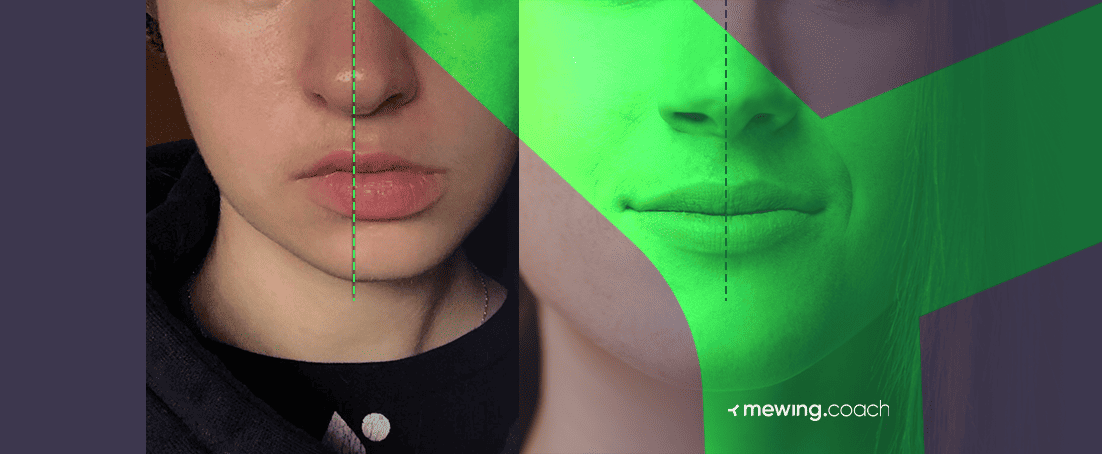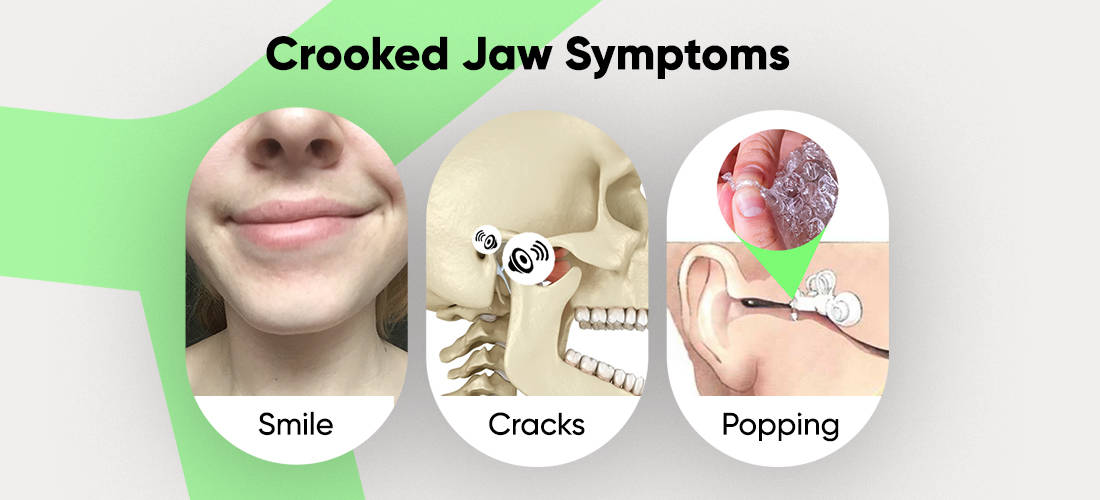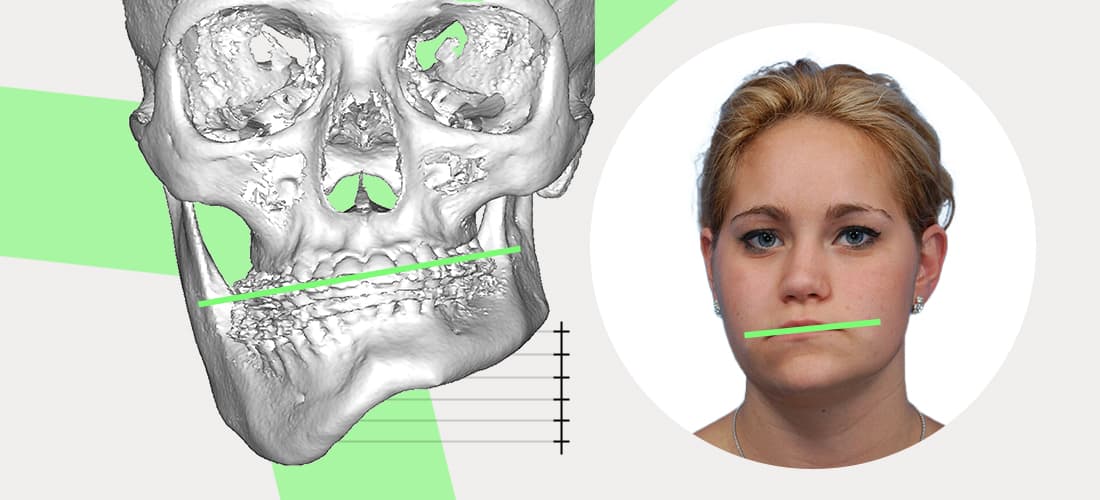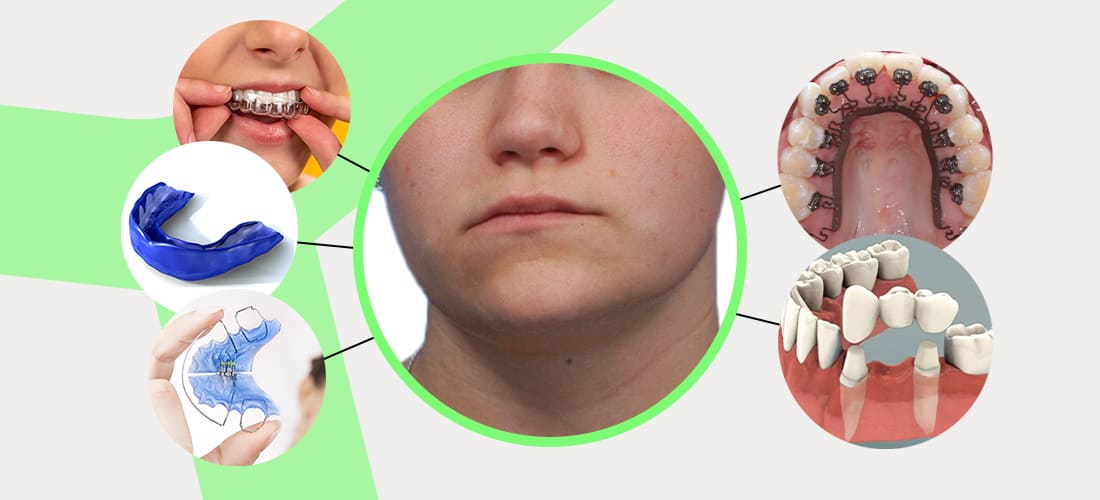Facial asymmetry can be harmless and a result of our lifestyle choices or lack of teeth alignment and bad oral health, but it can also be a result of an inborn jaw or chin asymmetry. On the other hand, others may have gotten the asymmetry due to an accident or injury.

And while asymmetrical jawlines can be fixed inherently by doing exercises for jawline improvement, some conditions will require minor interventions. Then again, some facial asymmetry cases point to serious medical conditions that should not be neglected.
Facial exercises have been gaining popularity as a natural and effective way to improve facial symmetry and tone. By targeting specific muscles, these exercises can help reshape your jawline and enhance the appearance of your chin.
Learn how facial workouts can fix an asymmetrical jaw. Start by completing the quick quiz below and get:
✅ Personalized face workout program (that’ll help you achieve a symmetrical jaw)
✅ Daily exercises
✅ Guidance on how to reach your goals
✅ Video guides, tips, daily reminders, etc.
In this post, we will discuss:
- 🔎 What causes facial asymmetry?
- 📝 The most common symptoms of an asymmetrical face
- 🤔 What treatment options are available
We created an in-depth guide to get a better jawline for men and women to help identify the best treatment option for you in finding and acquiring facial balance. Let’s get started!
What is Jaw and Chin Asymmetry?
Jaw asymmetry refers to a condition where the jawbone grows unevenly, which in turn results in a visibly unbalanced face. This points to a person with malocclusion, which simply means misalignment of the jaw and teeth, and in some cases, a rather underdeveloped jaw on one side of the face.
This facial asymmetry may be the cause of several difficulties faced daily. A person can get uncomfortable due to appearance, or it can affect biting and chewing. Luckily, this jaw imbalance can easily be corrected to accomplish facial symmetry by doing some simple exercises – more severe cases usually undergo cosmetic surgery treatments.
You May Have a Crooked Jaw if You Feel These Symptoms
An uneven jaw can have a significant impact on your health. Starting from your gums and teeth to muscles and ligaments, one needs to identify the problem before looking for possible solutions.
To determine whether you have a crocked jaw, here are some symptoms you should pay attention to:

Uneven Smile
Having an uneven or lopsided smile is one of the symptoms of facial asymmetry. It may be caused by nerve damage or dental problems. It is also not rare to see it in people who have suffered a stroke. The good news here is that a lopsided smile caused by a stroke will, in time, return to its normal state.
Jaw Popping and Clenching or Grinding Teeth
A dysfunctional temporomandibular joint or TMJ can cause a painful sensation of jaw popping. This sensation can be felt by people who clench their jaw, bite their fingernails, often chew gum, or bite their cheek and lips. These bad habits that we often do unconsciously can be the cause of pain in the jaw.
Teeth grinding or clenching is known as bruxism, a tension-related disorder, and can also cause jaw popping or clenching. It is often a result of anxiety and stress and should be addressed immediately.
Tight Jaw
A tight jaw can be the cause of discomfort throughout the body and have varying pain intensity. The pain may worsen when yawning or chewing. The symptoms of a tight jaw include locking the jaw joint, limited motion range when trying to open the mouth, and clicking sounds.
Popping in Ears
Unusual sensations or sounds like crackling or popping in the ears can be caused by several conditions like eustachian tube dysfunction and acute otitis media. However, it can also be caused by TMJ disorders.
These disorders can cause hearing popping and clicking sound close to the ear, especially while chewing or when the mouth is open.
Chin and Jaw Asymmetry Can Negatively Affect Your Appearance

When it comes to appearance, complete facial symmetry doesn’t exist, so those with nearly symmetrical faces are considered attractive. However, beauty standards are created by the fashion and entertainment industries.
Although we admire symmetrical beauty, it doesn’t mean it’s a symbol of beauty for everyone. Those aware of their facial structures often have asymmetrical faces, which can be normal, attractive, and desirable.
However, asymmetry can cause insecurities, affecting all aspects of life due to societal standards. Here are some asymmetrical facial features that can cause insecurities:
Excessive Gingival Display (Gummy Smile)
- Manifests when an excess of gum tissue is visible above the upper teeth while smiling.
- Can be triggered by factors such as a short upper lip, small teeth, an overgrown upper jaw, or enlarged gums (gingival hypertrophy).
- Many perceive it as unattractive and experience self-consciousness.
Facial Hyper Divergence (Long Face Syndrome)
- A condition inducing insecurity characterized by an elongated lower face, encompassing the chin and jaw.
- Can lead to a gummy smile and darkened skin beneath the eyes.
- May impact breathing, speech, and eating, potentially resulting in sleep apnea, snoring, jaw misalignment, and crowded or worn-down teeth.
Underbite (Protruding Lower Jaw)
- Dental misalignment where the lower jaw protrudes beyond the upper jaw, overlapping it.
- Severity varies based on how far the lower jaw extends past the upper teeth.
- Often rooted in skeletal issues but can also be influenced by genetics, injury, tumors, or childhood habits like pacifier use or thumb sucking.
Jaw Misalignment Could Also Be a Reason for Several Serious Dental Issues
Misaligned jaws may seem to be just a physical issue, when in fact, it can be a silent trigger for several dental issues. It is not rare that those with misaligned teeth clench and grind them. This, in turn, will lead to damaged teeth and receding gums, ending up with loose teeth, which will eventually be lost.
Below we’ve given some more details on each of the dental issues that may arise from jaw misalignment.
- Losing Teeth: TMJ issues can lead to health problems like headaches, jaw movement difficulties, and worn teeth, ultimately resulting in tooth loss. Missing teeth often contribute to TMJ disorders.
- Damaged Teeth: Jaw misalignment commonly causes broken and damaged teeth, which should be promptly addressed by an orthodontist to prevent further complications like tooth loss.
- Gum Recede: Gum recession can stem from various factors such as genetics, periodontal disease, oral hygiene, or teeth clenching. Overly aggressive brushing can erode tooth enamel and lead to gum recession.
- Tooth Looseness: Loose teeth can result from gum disease, tooth injury, or habits like teeth clenching and grinding. Gum inflammation or infection can also cause tooth looseness by affecting the alignment of the teeth.
Most Common Causes of Facial Asymmetry
We mentioned that there is no perfect symmetry when it comes to facial appearance, although we are all striving to achieve it. Most of the cases with an asymmetrical face are due to our genes – something we have inherited from our ancestors.
If other family members have the same nose slightly tilted to the side, or have a gummy smile or long face, then you know the cause for yours.
In most cases, these asymmetrical genetic features are not a cause for concern. However, there are also other possible causes of facial asymmetry that do require our attention and need to be addressed. Here are some of them:
- Trauma or Injury: Incidents such as jaw fractures, broken noses, or deep cuts can lead to facial asymmetry post-healing.
- Temporomandibular Joint Disorders (TMJ): Challenges with jaw joints, ligaments, and muscles from bruxism, injury, or misalignment can trigger crooked jaws.
- Birth Defects or Genetic Health Conditions: Conditions like hemifacial microsomia can result in facial irregularities, including chin asymmetries.
- Upper and Lower Teeth Misalignment: Malocclusion, such as overbite and underbite, can contribute to crooked teeth and jaw asymmetry.
- Smoking: Regular smoking patterns can modify facial features, causing facial asymmetry.
- Twisted Neck (Torticollis): Abnormal neck muscle positioning can induce head tilting and temporary facial asymmetry.
- Facial Nerves Paralysis: Ailments like Bell’s palsy can lead to facial nerve paralysis, resulting in drooping on one side of the face and asymmetry.
- Heart Attack, Stroke, or Cardiac Arrest: Diminished blood flow to the brain during a medical emergency can trigger sudden facial drooping and asymmetry.
- Teeth Alignment: Misaligned jaws due to teeth misalignment can be rectified using braces and retainers for enhanced symmetry.
Natural Ways to Fix Asymmetrical Jaw Features
As much as people are unhappy with their asymmetrical features, not everyone wishes to undergo medical treatments to correct them. Undergoing jaw surgery is no guarantee that the treatment will be effective and that the asymmetry will not return.
Many may not know that there are other natural and less invasive, less-costly ways to improve jawlines. It’s always best to start by working on the condition ourselves, and if this doesn’t have a fruitful result, we can turn to medical treatment at any time. Following below are some natural ways that you can use to fix your asymmetrical features.
Transform Facial Features With Mewing
Mewing is one of the many natural ways of transforming your facial features. A resourceful mewing definition would be that it is a practice that involves proper tongue posture aimed at improving face symmetry.
Proper change of tongue placement against the mouth roof can also strengthen the jawline. The unconscious or conscious changes in the tongue position can often be the cause of numerous health conditions which mewing can fix.
So if you’re wondering how mewing can fix uneven jaw, the answer is in our Mewing.coach app! This application offers everything you need to improve your jawline and facial appearance naturally. Reach the desired results through the provided workouts, video guidance, and personalized training programs, and evaluate your progress as you move along.
The Mewing.coach app is an excellent jawline guide for women and men who are looking to improve their asymmetrical jawline naturally.
Improving Your Posture
- Initiate immediate steps to enhance posture and address facial asymmetry.
- Maintain an upright spine, level shoulders, and refrain from slumping.
Facial Stretch Exercises
- Engage in exercises targeting facial muscles to enhance symmetry.
- Revitalize, fortify, and align muscles for a harmonious appearance.
- Consistent exercises are crucial for optimal outcomes.
Cheek Toning
- Enhance facial symmetry by manipulating cheek tissues.
- Apply gentle pressure with fingers on muscles and upper cheeks for desired effects.
Massage
- Utilize massage therapy to alleviate pain and swelling.
- Promotes healing and realignment of the jaw.
- Relieves tension in facial, neck, and upper cheek muscles.
Facial Acupuncture
- Diminish inflammation and boost blood circulation for improved facial symmetry.
- Target specific points on the jaw, face, and cheek tissues through stimulation.
- Enhances muscle function and eases tension for enhanced balance.
Dental Appliances That Help With Chin and Jawline Alignment
It may have been difficult in the past to fix an uneven jaw due to a lack of adequate tools and methods, but this is not the case today. Orthodontics and dental appliances are the answer to asymmetrical jaws as a result of malocclusion.
The use of pressure on the teeth and the jaw with the use of dental appliances encourages a healthier alignment. Here are some of these devices that can help out today:

Splints – Aligns the Teeth
Dental splints are specially designed devices that hold teeth together and help prevent harmful movement. To promote proper teeth alignment, splints are worn on the upper and lower teeth, and they are not removable.
Mouth Guards – Repositions the Jaw at Night Time
Mouth guards are specially designed devices to protect the teeth from grinding and clenching and help with TMJ. At the same time, they protect the supporting structures like the gums from damage. All in all, it’s a very helpful tool for those with pain and dysfunction history associated with TMJ or the bite.
Braces – Pushes Teeth Into Proper Alignment and Provide Additional Pressure to the Jaw
Braces are brackets that represent the cornerstone of orthodontic care. While we all know or have worn braces at one point in our lives, many wish to learn more on how braces change your jaw and help improve jaw alignment.
Braces provide pushing the teeth into proper alignment. At the same time, additional pressure on the jaw can be exerted through the use of orthodontic headgear.
Retainers – Correction of Tooth Alignment
Retainers can be used to support the work of braces while at the same time correcting tooth alignment. These clear aligners help teeth stay in the correct place. In other words, braces straighten teeth, and retainers keep them in that state.
Dental Bridges
The purpose of dental bridges is to cover the gap between teeth and prevent the shifting of the remaining teeth. They are false teeth attached to existing ones surrounding the missing teeth.
Chin Misalignment or Uneven Jaw Surgery
Not every uneven jaw and chin misalignment can be fixed with one of the proposed treatment methods. Natural treatment and dental appliances are not the answer to all facial asymmetry problems. Some cases will require a more serious approach, meaning jaw surgery will be required to fix any misalignment.
If you are someone who is highly bothered by the facial asymmetry you notice, make an appointment and discuss your condition with a doctor. Consulting a professional will allow you to better understand your condition and help you make the right decision that best suits you.
If jaw surgery is what the doctor recommends, below are several types of surgeries that you will need to consider.
Maxillary Osteotomy – Surgical Bone Removal
Maxillary osteotomy can correct open and crossbites by cutting the bone. It is an upper jaw surgery focused on correcting the overbite. This surgical method is used to create space and reposition the maxilla bone to line up with the lower jaw or the mandible.
Mandibular Osteotomy – Correction of Overbite and Protruding Lower Jaw
As the name suggests, a mandibular osteotomy is used in severe cases affecting the mandible. If there is an occurrence of severe overbite or a protruding lower jaw, surgeons move the lower jaw backward or forward.
This is done with the surgeon cutting the back of the mouth. The surgery’s aim is to properly line up the maxilla and mandibula.
Genioplasty – Correction of a Crooked Jaw
Those patients that need correction of a crooked jaw and reshaping of the mandible to realign the jaw imbalance need genioplasty. The surgery involves cutting the chin bone in the jaw’s front to restructure the jaw and chin.
Jaw Wiring – Positioning and Offering Support to the Jaw
In cases of jaw fractures and following surgery, patients may need temporary jaw wiring. This is used for positioning the jaw in place and offering support when the jaw bones are fractured or broken.
In some cases, pins may be used to support the structure and correct the misalignment. In addition, you can try jawline exercises after surgery.
Key Takeaways
There is nothing unusual about having facial asymmetry. In fact, it is a rather common and normal condition that is a result of genetic health conditions, trauma or injury, birth defects, TMJ, or even lifestyle choices.
Luckily, for those looking to make a change in their facial features, there are numerous natural ways in which this asymmetry can be corrected. If the asymmetry is a consequence of an injury and accident and causes health problems and discomfort, it is wise to ask for medical assistance.
But everyone else can easily benefit from a simple exercise like mewing. The Mewing.coach app is the best partner in natural treatment. It offers personalized workout plans to daily face toning exercises that will help you complete your goal.
So don’t wait – start mewing today and get the facial features you’ve dreamed of!





